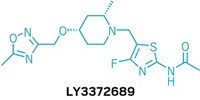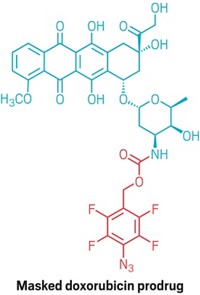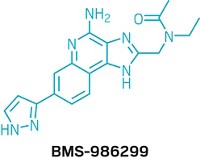Advertisement
Grab your lab coat. Let's get started
Welcome!
Welcome!
Create an account below to get 6 C&EN articles per month, receive newsletters and more - all free.
It seems this is your first time logging in online. Please enter the following information to continue.
As an ACS member you automatically get access to this site. All we need is few more details to create your reading experience.
Not you? Sign in with a different account.
Not you? Sign in with a different account.
ERROR 1
ERROR 1
ERROR 2
ERROR 2
ERROR 2
ERROR 2
ERROR 2
Password and Confirm password must match.
If you have an ACS member number, please enter it here so we can link this account to your membership. (optional)
ERROR 2
ACS values your privacy. By submitting your information, you are gaining access to C&EN and subscribing to our weekly newsletter. We use the information you provide to make your reading experience better, and we will never sell your data to third party members.
Drug Development
LGX818, Made To Fight Melanoma
by Carmen Drahl
April 22, 2013
| A version of this story appeared in
Volume 91, Issue 16

Targeted drugs such as Gleevec have changed the face of cancer therapy. But cancer has a way of developing resistance to even these customized treatments, which are designed to block kinase enzymes gone awry. At the meeting, Novartis chemistry group leader John Tellew talked about LGX818, a drug candidate taking aim at resistant melanoma.
Roughly 50% of all melanoma patients have tumors with a mutation to a kinase called BRAF, which normally transmits cell growth signals. The most common BRAF mutation, which replaces a valine amino acid with a glutamic acid, also occurs in some colon and thyroid tumors. This abnormal BRAF turns the signaling pathway on in an unregulated fashion. A drug on the market called vemurafenib targets this V600E mutation specifically. But while patients initially respond to this drug, nearly all develop resistance and relapse within months.
To face this challenge it took two teams at the Novartis Institutes for Biomedical Research—Tellew’s, in San Diego, and Daniel J. Poon’s, based in Emeryville, Calif. The groups had regular videoconference meetings and shipped samples to each other, up and down the California coast, Tellew told C&EN.
LGX818

Company: Novartis Institutes for Biomedical Research
Target: V600E BRAF kinase
Disease: melanoma
It’s possible to block BRAF with molecules that bind to any of several forms of the kinase, including the active form and two inactive conformations. The Novartis team began by targeting the active form. Phenol and oxime motifs are common in these types of inhibitors, but they can lead to compounds with too poor pharmacokinetics to be useful.
Working with a triarylimidazole skeleton, the team found that 2-amino-3-methoxypyridine was a decent replacement for the phenol or oxime. Although the resulting compounds passed biochemical tests for selectivity and druglike properties, they didn’t shrink tumors in mice at tolerated doses, so it was back to the drawing board.
With abbreviated efficacy and tolerability studies in mice, designed to speed throughput, they evaluated many compounds until they found better options, such as sulfonamides. Their drug candidate, LGX818, emerged after extensive tweaks to a sulfonamide. It binds not to the active form of the kinase but to an inactive form—much like vemurafenib. Compared with vemurafenib, however, LGX818 was superior at killing mutant BRAF tumor cells.
In rat and mouse toxicology studies, LGX818 performed well. The compound also shrank grafted human tumors bearing the V600E BRAF mutation in rats and mice.
LGX818 is currently in Phase Ib/II clinical trials. Patients with colon cancer or melanoma with the BRAF mutation, including patients resistant to other BRAF-targeted drugs, are receiving LGX818 pills alone or as part of drug cocktails to determine whether the drug is safe and efficacious.






Join the conversation
Contact the reporter
Submit a Letter to the Editor for publication
Engage with us on Twitter